Car crime is on the rise – and Range Rovers are particularly in danger as professional gangs target the sought-after motors.
Vehicles thefts were up 8 per cent annually to 132,489 cases between October 2022 and September 2023, according to Office for National Statistics data published last week.
The latest increase comes amid the recent spike in keyless car crime, which is now the most common tactic used by organised criminals to steal motors.
And for Range Rover owners, this is having a double whammy impact: not only are the premium SUVs among the most targeted by gangs of car thieves, but the knock-on effect has sparked huge increases in insurance premiums for the vehicles.
We’ve spoken to Jaguar Land Rover (JLR) to explain how owners of Range Rovers can best protect them from thieves. And we’ve added guidance from experts in the field of motor crime and vehicle security to help all drivers keep their motors safe.
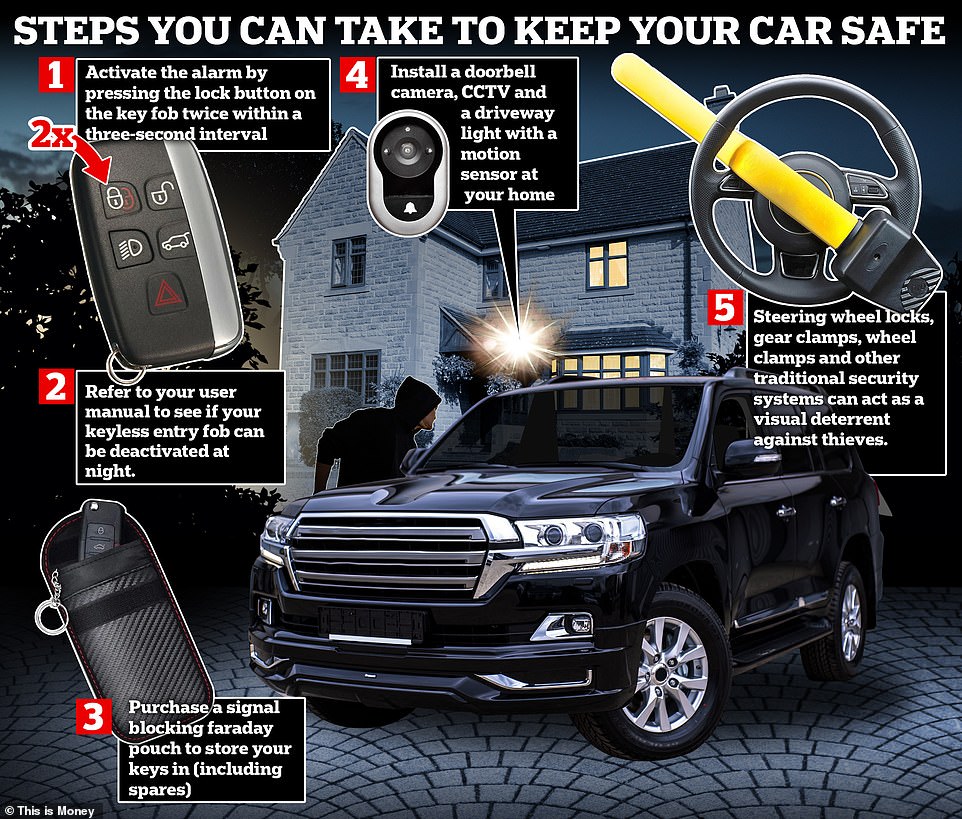
Jaguar Land Rover and a number of experts in the field of motor crime and vehicle security explain how owners of Range Rovers – and all other brands – can best protect them from thieves and the new tactics they’re using to pinch cars
Exclusive DVLA data shared with MailOnline and This is Money shows the Range Rover Sport was the fifth most-stolen car in Britain in 2023, with 1,631 pinched from owners last year.
The Range Rover Evoque (1,489 stolen) and Land Rover Discovery Sport (954) also made the top 10 of most taken models last year.
The new data follows a separate report from last year that calculated that the Range Rover Velar is the most stolen motor per examples on the road, with two in every 100 being reported taken over a 12-month period.
With the brand’s luxury SUVs increasingly targeted by criminals, premiums for these cars have gone through the roof – and in many instances, insurers won’t cover them at all.
Even JLR’s own insurance product – launched last year specifically to tackle the issue – has been rejecting owners.
Steve Launchbury, principal security engineer at automotive risk intelligence company Thatcham Research, told This is Money that a rise in thefts is the result of organised criminality, with ‘sophisticated criminal gangs directing significant resources towards seeking out car security vulnerabilities’.
With police resources stretched, Launchbury says premium vehicle thefts – such as Range Rovers – present a profitable and relatively low risk option for thieves.
‘The internet and social media platforms also offer the opportunity for the sharing of vulnerabilities to wide criminal communities, in an instant. Digital devices with valid primary functions are also being reverse engineered for criminal means and can be easily found and purchased online,’ he tells us.
‘Many manufacturers have implemented effective counter measures, making vehicles with keyless entry systems more resilient to the so-called relay attack.
‘As a result, more recently launched models are less susceptible to this theft technique.’
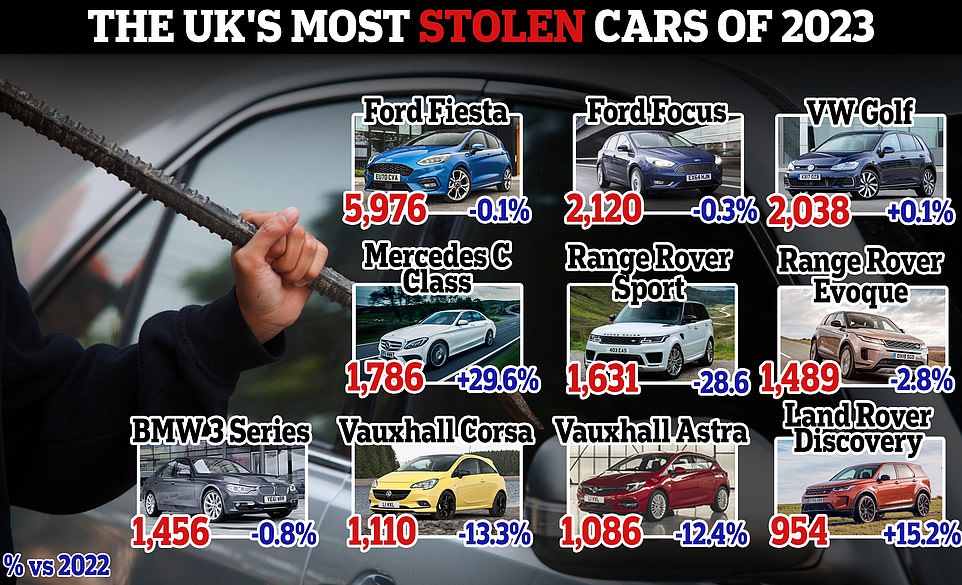
DVLA figures show Range Rover thefts across all models (including Range Rover, Range Rover Sport, Range Rover Evoque and Range Rover Velar) declined by almost 20% between 2022 and 2023. The Range Rover Sport is the 5th most-stolen car of last year (Evoque 6th and Land Rover Discovery Sport 10th)

Jaguar Land Rover has invested millions of pounds to tackle the big rise in thefts of Range Rover models – but is it working?
WHAT HAS JLR DONE TO TACKLE THEFTS OF ITS VEHICLES?
Acknowledging the threat to its vehicles, JLR in November announced it will take the fight to well-funded keyless, tech-equipped car thieves by investing millions to protect customers from the rise in this type of crime.
It confirmed it will fork out £10million retrofitting older models with its latest security technology to create a virtual barrier to block the recent spate of breaches.
The security rollout relates to the Body Control Module (BCM) attack – a different keyless theft method to ‘relay attacks’, which is when criminals duplicate the signal from the key inside a home to unlock a car.
BCM breaches are where criminals hack the keyless entry system enabling them to start the engine.
Only models from 2018 onwards are eligible for the upgrade, with more than 79,000 vehicles already receiving it.
‘These updated vehicles are now immune’ to this type of keyless car crime and ‘no vehicles which have had this update have been stolen via the BCM method,’ JLR told us.
In fact, since January 2022, only 0.07 per cent of new Range Rover and Range Rover Sports on the road with the latest security setup have been pinched, while only 0.3 per cent of new Defenders had been affected since 2020, the company said.
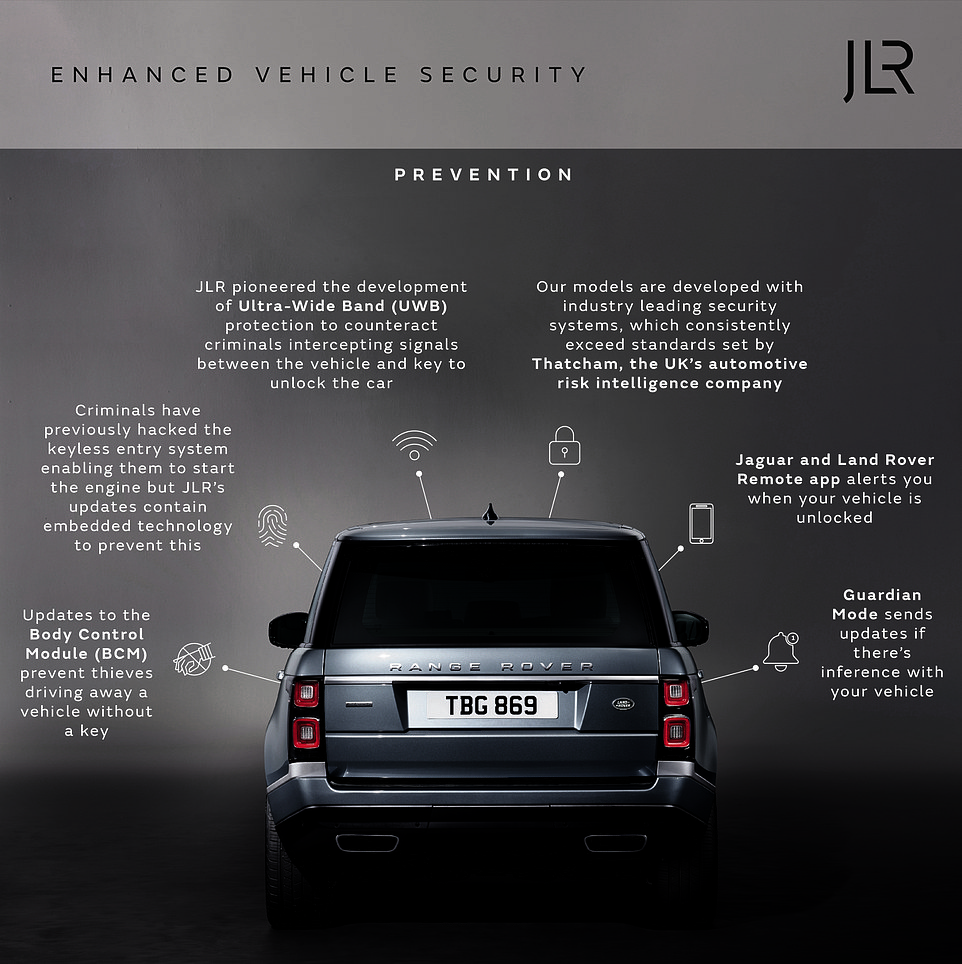
In 2018, JLR also pioneered the development of Ultra-Wide Band (UWB) protection to counteract relay theft methods.
It assures us that any car with the latest UWB setup is not vulnerable to this theft method.
And there is evidence that JLR’s efforts and new tech is having an impact.
DVLA records show that the number of all Range Rover variants (including Range Rover, Range Rover Sport, Velar and Evoque) stolen in 2023 declined by almost 20 per cent compared to 2022.
Figures from the Police National Computer Data also show a similar downward trend of thefts of Range Rover vehicles, with a 26 per cent reduction between November 2022 and the same month last year.
The brand also exclusively revealed to This is Money it is providing ‘hundreds of thousands of pounds’ in funding to police forces to help them to tackle the flow of stolen vehicles swiftly being exported out of the country.
Patrick McGillycuddy, JLR UK managing director, told us: ‘The rapid decline in Range Rover thefts in the last year, demonstrates the strength of our latest vehicle security measures.
‘These significant reductions are a result of engineering our new vehicles to be robust against all known theft methods through the latest anti-theft technology, endorsed by third party experts like Thatcham.
‘In fact, our latest data shows that only ten out of 12,200 of the latest model of Range Rovers have been stolen since January 2022.’

Jaguar Land Rover gives its customers five additional security recommendations to help them avoid falling victim of car crime
JLR’S FIVE ADDITIONAL SECURITY RECOMMENDATIONS FOR CUSTOMERS
While JLR is spending millions upgrading its vehicle’s security systems to fight keyless car thefts, it offers the following additional advice to its customers regarding extra precautions to take to reduce the chances of thieves attempting to steal their cars:
1. Always lock your car when leaving it unattended.
2. Activate the alarm by pressing the lock button on the key fob twice within a three-second interval.
3. Use the InControl Remote app and switch on Guardian Mode for added security. This provides vehicle lock reminders and also monitors the vehicle and provides an alert if there is any unauthorised interaction.
4. Ensure the Secure Tracker/Secure Tracker Pro is activated if your vehicle has this feature. This alerts owners and the ‘Stolen Vehicle Tracking Centre’ if there’s an attempt to steal your Range Rover. In the first instance, a theft notification will be sent to the centre where one of the operators will get in touch. Notifications will also pop up on the Remote smartphone app and the InControl website, advising owners to contact the tracking team.
5. Don’t leave keys where they can be easily taken, for example near a letterbox – but do not hide them. If thieves break into your home, it is far better for your safety that they do not confront you for your keys.
CAR THEFTS – WHAT DRIVERS OF CARS FROM ALL BRANDS NEED TO KNOW
There are four hi-tech methods being utilised by thieves to steal an increasing number of cars with keyless technology.
While these tactics are often used to target luxury models, organised gangs armed with the right technology are can use these methods to infiltrate a wide variety of vehicles – especially those with keyless systems:
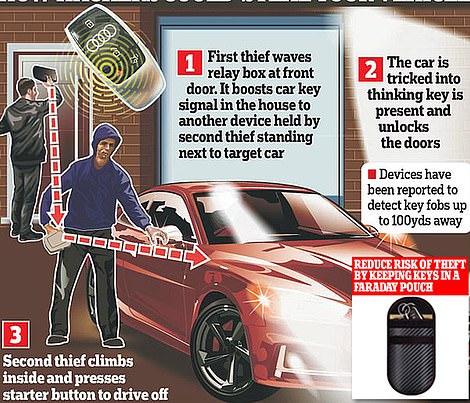
Around half of all car thefts in the UK today are carried out using relay attacks on keyless cars, insurers have estimated
1. Relay attack
The first is the ‘Relay Attack’, which is the one most synonymous with the spike in keyless vehicle crime.
Typically, two thieves will work together, one holds a transmitter next to a car parked on a driveway while the other stands close to the property holding an amplifier.
The amplifier can boost the signal from the key inside the home and send it to the transmitter.
The transmitter essentially becomes a ghost key and tricks the car into thinking the real key is nearby and opens the doors.
Around half of all car thefts in the UK today are carried out using relay attacks on keyless cars, insurers have estimated.
2. Key cloning
In this instance, a victim’s keys are usually acquired through places such as unscrupulous garages or car washes.
Criminals can then use a device to clone the car keys without the owner’s knowledge by copying its unique signal code onto a blank key.
The genuine key is then returned to the owner and the car and thieves follow them to their home address – or check their customer files – to return at a later time or date to steal the car with the duplicated key.
3. Signal blocking
Signal blocking is a commonly used tactic to steal vehicles in busy car parks.
Thieves will watch for when a driver exits their car and is about to press the lock button on the key fob.
They will then use a signal jammer to block the key from contacting the car in the hope that the owner fails to notice the locks haven’t engaged – which is usually alerted with the warning lights blinking and an audible ‘beep’.
With the car doors remaining unlocked, this provides easy access for thieves.
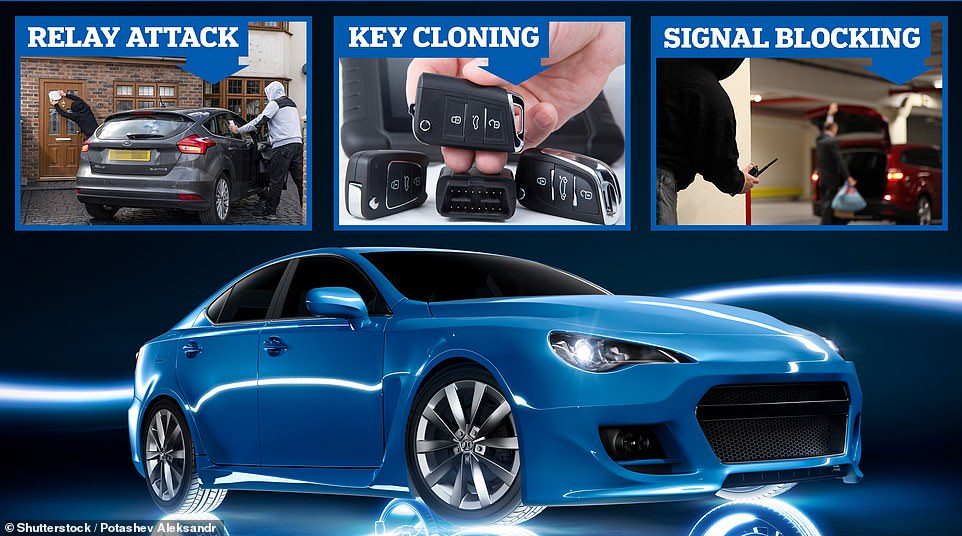
There are primarily three hi-tech theft tactics that have been used by professional gangs to pinch high-value motors – but experts warn there is a new method that they’re using
4. The new one – attacking a vehicle’s Controller Area Network
Thieves have recently started to use a new tactic to infiltrate the latest vehicles, Thatcham Research warns.
Steve Launchbury tells us: ‘Criminal gangs are now gaining access to a vehicle’s Controller Area Network (CAN) – which is required for digitally enabled safety and convenience functions (such as automatic emergency braking and headlights etc) – often by brazenly cutting into the tailgate or body panels.’
The CAN is rather like the nervous system of a car – it enables communication between the various electronic control units’ (ECUs) in a vehicle, with the latest models have around 70 ECUs in total.
By accessing the CAN, thieves can infiltrate any aspect of the car, including the vehicle’s locking system and keyless ignition.
EXTRA MEASURES TO TAKE IF YOU HAVE A CAR WITH KEYLESS TECH
If your car has Passive Keyless Entry and Start (PKES), it may be susceptible to the relay attack theft method.
Thatcham Research explain several steps you can take to make it harder for thieves using this method:
1. Purchase a signal blocking faraday pouch to store your keys in (including spares). Make sure the pouch is designed specifically for keys and test it by inserting your fob into the pouch and attempting to open your vehicle.
2. Refer to your user manual to see if your keyless entry fob can be deactivated at night.
3. Check that you have a motion-sensor enabled fob, which goes to sleep when idle (i.e., when stored at home). Most vehicle manufacturers now produce this type of fob.
4. Keyless entry systems that use an ultra-wideband (UWB) transmission signal – like the one developed by JLR – are not susceptible to relay attacks.
5. Remember the thieves may also operate their relay system even when a driver visits their office or shops with the key in their pocket or bag.
WHAT STEPS DO I TAKE IF MY CAR HAS BEEN STOLEN?

Scott Dixon aka The Complaints Resolver gives his top tips to avoid buying a clocked car
Scott Dixon, consumer and motoring disputes expert and the man behind the successful Complaints Resolver website gives a step-by-step guide on what to do if your car has been stolen.
1. Make sure your car has actually been stolen before reporting it
Double-check that your vehicle has really been stolen before you call the police and your insurer.
Ask yourself the following questions:
Was your vehicle parked where you thought it was?
Has your partner or family member used the car without you knowing?
Was your vehicle parked illegally? If so, it may have been towed away by the Council and in a vehicle compound.
Only once you have the answer to these questions should you move on to contacting the authorities.
2. Only call 999 if the theft is an emergency
If you are sure your vehicle has been stolen, contact the police on 101 with the vehicle registration number, make, model and colour of the vehicle.
Only dial 999 if you consider the situation an emergency, such as the thieves taking your car at that very moment or being inside your home.
3. Provide as much info as possible to the police
If you have photos of your car on your phone, provide them to the police to help them help you find your car.
If your property has CCTV or a doorbell with a camera, tell the police to they can view the footage as part of their investigation. Let them know if your car has a black box/tracking device for insurance purposes, which may help them quickly recover your vehicle.
If your car has an aftermarket tracking device fitted, also contact the supplier to make them aware your car has been taken.
4. If the car is financed or leased, let the lender know it has been pinched
You may not be the owner of the stolen vehicle.
If the vehicle has been hired, leased or you have outstanding finance on the car, you will need to contact the lender/registered owner of the vehicle.
Any party with a financial interest or ownership of the vehicle will need to be notified immediately and put in touch with your insurance company.
5. Let your insurer and the DVLA know your car is stolen
If your car is confirmed stolen, you will need to let your insurer know.
You will also need to inform the DVLA if your insurance company pays out. The reason for this is because the insurance company becomes the registered keeper of the vehicle.
This applies even if the vehicle is eventually recovered, as they will have settled your claim and effectively transferred ownership.
6. Provide evidence for the value of your car if you’re unhappy with the insurance pay out
After making a claim following a theft, not all car owners are satisfied with how much the insurer offers.
To prevent this happening to you, gather your evidence to prove the car was worth more by using car price guides and prices online.
Claims can take some time to be settled. The Financial Conduct Authority (FCA) rules say that your insurer must either make a reasonable offer to settle your claim within 3 months. This is covered in Chapter 8 of the FCA Handbook.
Follow your insurer’s internal complaints process if you believe there are unreasonably long delays in settling your claim without good reason and cite what the FCA says regarding claims settlements.
YOUR RIGHTS IF PERSONAL ITEMS ARE STOLEN FROM YOUR CAR
In cases where the vehicle isn’t stolen but items inside it are, there are a number of recommendations Scott Dixon has in order to help victims receive compensation.
‘It is worth checking your home insurance policy to see if items such as wallets, laptops, mobile phones and other electronic devices are covered,’ Scott tells us.
‘By claiming on your home insurance instead of your car insurance for such items, you keep your car insurance ‘no claims’ intact. This will reduce the perceived risk an insurer takes when your car insurance is due for renewal and keep your premium down.’
However, you cannot claim on both insurance policies and insurance firms share data to mitigate fraudulent claims.
The Association for British Insurers (ABI) say: ‘Tackling insurance fraud remains an industry strategic priority.
‘In 2022, insurers detected 72,600 dishonest insurance claims valued at £1.1billion.
‘It is estimated that a similar amount of fraud goes undetected each year.’
Some links in this article may be affiliate links. If you click on them we may earn a small commission. That helps us fund This Is Money, and keep it free to use. We do not write articles to promote products. We do not allow any commercial relationship to affect our editorial independence.









